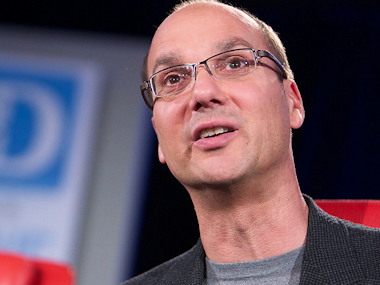Android’s Father Won’t Soon Be Forgotten (Video)

Asa Mathat / AllThingsD.com
His surprise shift away from the team and product he gave birth to leaves many unanswered questions about Google’s mobile future. Rubin’s future is unclear as well, as the memo from Larry Page says only that he will be working on “moonshots” (it’s unclear where in Google’s organization one creates moonshots, though Google X would be one logical spot.)
However, Rubin’s legacy is clear.
Before creating Android, Rubin led Danger, maker of the T-Mobile Sidekick. That phone, also known as the Hiptop, was arguably the first true smartphone, merging a phone with a real browser.
The first version, which debuted in 2002, was in black and white only, had an add-on camera with only a few pixels of resolution and felt like a bar of soap in the hand.
But it gained a huge following both among techies and teens who liked its great keyboard for texting and email.
Along with Joe Britt and Matt Hershenson (who are both now also at Google), Danger added color and other features to the phone, but struggled as a small company competing against Palm, BlackBerry, Microsoft and others.
Rubin left Danger and launched Android, the startup, which was acquired by Google in 2005. Danger itself ended up being purchased by Microsoft, where much of the remaining team worked on what became the ill-fated Kin.
And while it took years to pull off, Android became the ubiquitous phone platform that Danger had once hoped to be. From a lone initial phone, the G1, Android is now on 750 million devices (and 1.5 million more each day).
Google has tried, albeit without much success, to move Android beyond phones and tablets into all manner of other devices, from cameras to robots, and especially into audio and living room devices. Google TV, for example, is based on Android.
However, Google TV has struggled to win a place in the living room, seeing little success despite recruiting major manufacturers like Sony, LG and Logitech to build Google TV set-top boxes.
Meanwhile, the Nexus Q — an Android-powered, living-room-centric companion device for audio and video — never even made it to market.
Still, despite facing headwinds in expanding the platform beyond mobile devices, Rubin will be remembered as the man who helped wrest the stranglehold of the smartphone market away from the established giants, while ushering in a new era of mobile-focused revenue streams for Google.
Rubin appeared onstage three times at AllThingsD events. Here’s an interview with Rubin from AsiaD in 2011.
Before that, Rubin appeared at our D: Dive Into Mobile event in late 2010:
He also appeared at D@CES earlier that year.
Additional reporting by Mike Isaac









